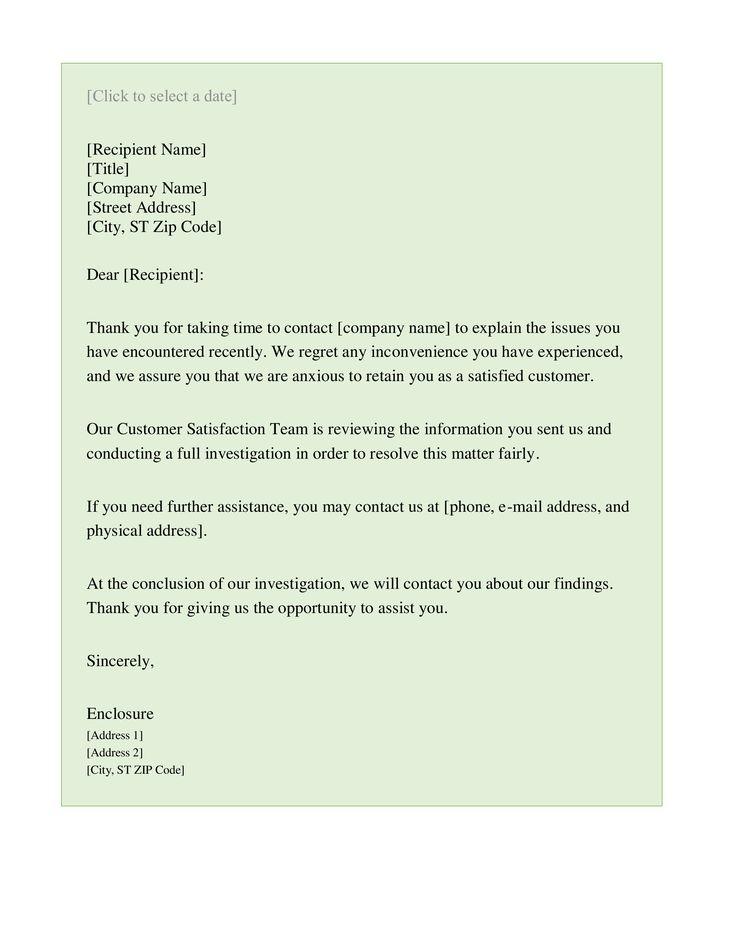When a customer voices a complaint, see it as an opportunity! Acknowledge their feelings, respond promptly, and offer a solution. This builds trust and shows you care. Remember, turning a complaint into a positive experience can win a loyal customer!
How To Respond To Customer Complaints
How to Respond to Customer Complaints: Turning Challenges into Opportunities
Let’s face it: customer complaints can feel like a punch to the gut. Whether it’s a scathing review or a frustrated call, it’s easy to see these moments as setbacks. But what if I told you that each complaint holds the potential for growth—not just for your business, but for you as a professional? Imagine transforming that dissatisfaction into loyalty and turning a critic into your biggest advocate. In this article, we’ll explore effective strategies to respond to customer complaints in a way that not only resolves the issue but also strengthens your relationship with your customers. So, if you’re ready to embrace the challenge and learn how to handle complaints like a pro, let’s dive in!
Understanding the Importance of Customer Complaints
Customer complaints are often viewed as a hassle, but they can be one of the most valuable tools for a business. When customers take the time to voice their concerns, they are providing you with insights that you might not have otherwise recognized. This feedback allows you to improve your products, services, and overall customer experience.
Listening to customer complaints can yield several key benefits:
- Identifying Weaknesses: Complaints often highlight areas where your business may be falling short, whether it’s product quality, customer service, or delivery times. Addressing these weaknesses can significantly enhance customer satisfaction.
- Building Relationships: Responding positively to complaints can strengthen your relationship with customers. They appreciate when a business takes their concerns seriously and acts to resolve issues.
- Enhancing Reputation: Customers are more likely to recommend a business that listens and responds well to their concerns. A good reputation can lead to increased customer loyalty and attract new clients.
Moreover, effectively handling complaints can provide you with a competitive edge. Customers are more likely to choose a company that demonstrates excellent customer service, even if mistakes occur. This proactive approach in addressing complaints not only shows that you care but also positions your brand as trustworthy and responsive.
To make the most out of customer complaints, consider implementing a structured approach. Here’s a simple table to guide you through an effective response process:
| Step | Action |
|---|---|
| 1 | Listen Actively |
| 2 | Apologize Sincerely |
| 3 | Investigate the Issue |
| 4 | Offer a Solution |
| 5 | Follow Up |
This table presents a systematic way to address complaints that not only resolves the issue but also reinforces customer loyalty. Each step plays an essential role in transforming a negative experience into a positive one.
embracing customer complaints as opportunities rather than setbacks can significantly benefit your business. By fostering an environment where customers feel heard and valued, you pave the way for growth, improvement, and lasting loyalty.
Listening Actively to Your Customers Concerns
Engaging with your customers’ feedback is not just a reactive measure; it’s a proactive strategy that can foster loyalty and trust. When a complaint arises, it’s crucial to approach the situation with an open mind and a willingness to understand. Here are a few essential tactics to enhance your active listening skills:
- Give Full Attention: When a customer reaches out with a concern, ensure you are fully present. Put aside distractions and focus solely on the conversation at hand.
- Ask Clarifying Questions: Don’t hesitate to dig deeper. Asking questions not only shows you care, but it also helps you grasp the full context of the issue.
- Paraphrase Their Concerns: Repeat back what the customer has expressed, using your own words. This demonstrates that you have heard them and are engaged with their issues.
Furthermore, it’s important to validate their feelings. Customers want to know that their problems are recognized and respected. A simple acknowledgment can go a long way. Phrases like “I understand how frustrating that must be” can create a connection and show empathy. This is particularly effective because it transitions the conversation from a complaint to a collaborative dialogue.
| Customer Emotion | Response Techniques |
|---|---|
| Frustration | Empathize and apologize sincerely. |
| Confusion | Clarify the issue and provide detailed explanations. |
| Disappointment | Offer solutions and reassure commitment to quality service. |
Another key aspect of listening actively is to take notes during the conversation. This not only helps you remember the details but also signals to the customer that their concerns are important enough to be documented. After the discussion, summarize the main points to ensure you have captured everything accurately and show that you are taking their feedback seriously.
follow-up is essential. After addressing the complaint, reach out to the customer to inform them of the actions taken or to check whether their issue has been resolved. This reinforces that you value their feedback and are committed to continual improvement. Building a relationship based on trust and open communication is invaluable in today’s competitive market.
Empathizing with the Customer: Why It Matters
Understanding the emotions and experiences of your customers is crucial in today’s marketplace. When a customer reaches out with a complaint, they are not just voicing frustration; they are sharing a part of their journey. By actively listening and empathizing, you can transform a negative encounter into a powerful opportunity to build loyalty and trust. Here’s why doing so matters:
- Enhances Customer Loyalty: When customers feel heard and understood, they are more likely to return. A genuine response can turn one-time buyers into lifelong advocates of your brand.
- Improves Communication: Empathetic interactions make it easier for customers to express their concerns. This clear communication can lead to better solutions and a more effective resolution process.
- Fosters a Positive Brand Image: Customers who experience empathetic care are likely to share their positive experiences with others, enhancing your reputation in the market.
To effectively empathize, consider incorporating these strategies into your responses:
| Strategy | Description |
|---|---|
| Active Listening | Focus fully on the customer, acknowledging their feelings without interruption. |
| Personalized Responses | Use the customer’s name and reference specific details about their issue to show you care. |
| Apologize Sincerely | A genuine apology can diffuse tension and demonstrate that you value their experience. |
| Follow Up | Check in after the issue has been resolved to ensure satisfaction and reinforce your commitment. |
Incorporating empathy into your customer service strategy creates a ripple effect that can elevate your business. When customers feel valued, they are not just more likely to resolve their complaints; they are also more likely to share their positive experiences with friends and family. In a world where customer opinions can quickly shape a brand’s image, this can be the difference between success and obscurity.
Ultimately, viewing complaints as opportunities for connection rather than obstacles is key. By practicing empathy, you demonstrate not just a willingness to address issues but a commitment to customer relationships. This approach not only helps resolve immediate concerns but also sets the stage for long-term success.

Crafting a Thoughtful Response: The Key to Resolution
When a customer voices a complaint, it’s not just an inconvenience; it’s an opportunity to showcase your commitment to quality service and customer satisfaction. Responding thoughtfully can turn a frustrated customer into a loyal advocate for your brand. Here’s how to craft a response that resonates.
Listen Actively
Before crafting your response, it’s essential to understand the complaint fully. This means listening not just to the words but also to the emotions behind them. Acknowledge the customer’s feelings and validate their experience. For example:
- “I understand how frustrating this situation is for you.”
- “Thank you for bringing this to our attention; I can see why you would feel upset.”
Personalize Your Message
Generic responses can often feel dismissive. Tailoring your reply to the specific situation shows the customer that you value their individual experience. Address them by name and reference their specific complaint. A personalized touch can significantly enhance the effectiveness of your response.
Propose a Solution
After acknowledging the issue, it’s crucial to present a clear solution. Customers appreciate knowing that their concerns are being taken seriously and that you’re willing to make things right. Here’s a simple way to structure your solution:
- Outline the steps you’ll take to resolve the issue.
- If applicable, offer compensation or a discount as a goodwill gesture.
- Provide a timeframe for when the customer can expect a resolution.
Follow Up
Resolution doesn’t end with your initial response. Following up demonstrates your continued commitment to customer satisfaction. A simple message asking if the issue has been resolved to their satisfaction can go a long way. Consider this:
| Follow-Up Action | Purpose |
|---|---|
| Send a Thank You Note | To express gratitude for their feedback. |
| Request Feedback on Resolution | To ensure the solution met their expectations. |
| Invite Them to Share Their Experience | To encourage positive word-of-mouth. |
Maintain a Positive Tone
Throughout your response, keep the tone positive and reassuring. Avoid defensive language, and instead, focus on how you’re here to help. Phrases like “We appreciate your feedback” or “We’re here to support you” can help to create a more constructive dialogue.
When handled correctly, customer complaints can lead to meaningful engagement and improvement. By responding thoughtfully, you not only resolve the immediate concern but also reinforce your brand’s reputation and build lasting customer relationships.

Turning Complaints into Opportunities for Improvement
Every complaint is a window into the expectations and desires of your customers. Rather than viewing these complaints as mere obstacles, think of them as valuable insights that can drive your business forward. When a customer takes the time to voice their concerns, they are essentially giving you a roadmap to enhance their experience. This is your chance to turn dissatisfaction into loyalty.
Responding effectively to customer complaints involves a blend of empathy, communication, and action. Here are some strategies to consider:
- Listen Actively: Make sure to give your full attention to the customer’s concerns. This demonstrates that you value their opinion and are committed to addressing their issue.
- Empathize: Acknowledge their feelings. A simple “I understand how frustrating this must be” can go a long way in diffusing a tense situation.
- Take Ownership: Even if the issue was not directly your fault, owning the problem can help build trust. Let the customer know that you are there to help resolve it.
- Provide Solutions: Once you understand the complaint, focus on practical solutions. Offer alternatives or compensation where appropriate, showing your commitment to making things right.
- Follow Up: After resolving the issue, reach out to the customer to ensure their satisfaction. This not only reinforces your dedication but also opens the door for further feedback.
It’s essential to maintain a positive tone throughout your interactions. Even in situations where the customer is upset, your attitude can influence the outcome significantly. Consider creating a response template that incorporates these elements while still allowing for personalization based on the specific complaint.
| Complaint Type | Potential Opportunities |
|---|---|
| Product Defect | Quality Improvement |
| Shipping Delay | Logistics Optimization |
| Poor Customer Service | Training Enhancement |
| Website Issues | User Experience Upgrade |
When you analyze the complaints you receive, look for patterns that might indicate larger issues within your operations. By categorizing complaints and tracking them over time, you can identify recurring problems. Addressing these root causes not only helps reduce future complaints but also enhances the overall customer experience.
Ultimately, transforming complaints into opportunities for improvement is about creating a culture of responsiveness and adaptability within your organization. By fostering an environment that encourages feedback and actively seeks solutions, you empower your team to turn challenges into stepping stones for success.

Following Up: How to Show You Care
Once you’ve addressed a customer complaint, the journey doesn’t end there. Following up is a crucial step that demonstrates to your customers that you genuinely care about their experience and satisfaction. Here are a few effective strategies to ensure your follow-up is both meaningful and impactful.
- Personalized Communication: Tailor your follow-up messages to the specific issue raised by the customer. Use their name and reference the complaint directly. This personal touch can make a world of difference.
- Ask for Feedback: Encourage customers to share their thoughts on how the issue was resolved. This not only shows that you value their opinion but also provides you with insights to improve your service.
- Offer Solutions: If feasible, present additional solutions or compensations that could enhance their experience. It could be a discount, a free service, or a small gift. This gesture can turn a negative experience into a positive one.
- Set a Follow-Up Reminder: If the issue requires ongoing attention, schedule a follow-up check-in. This not only reassures the customer but also reinforces your commitment to excellent service.
Utilize email or phone to reach out, depending on what the customer prefers. Here’s a simple table to illustrate effective follow-up methods:
| Method | Best For | Notes |
|---|---|---|
| Non-urgent issues | Allows for detailed responses. | |
| Phone Call | Urgent concerns | More personal and immediate. |
| Social Media | Public visibility | Great for customer engagement. |
Remember, the key to effective follow-ups is sincerity. Your customers want to feel heard and valued. A simple message saying, “We appreciate your feedback, and we’re here to help,” can go a long way. By actively engaging with your customers post-complaint, you’re not just resolving issues—you’re building lasting relationships.
Incorporating follow-ups into your customer service strategy demonstrates a commitment to excellence. It reflects a company culture that prioritizes customer satisfaction and adaptability. So, don’t let a complaint be the end of a conversation. Make it the beginning of a stronger relationship.

Creating a Complaint Response Template for Consistency
Establishing a complaint response template is essential for maintaining consistency in your customer service approach. When customers reach out with issues, a well-structured response not only addresses their concerns but also reinforces your brand’s commitment to customer satisfaction.
Here are some key components to include in your template:
- Personalized Greeting: Always start with the customer’s name to make them feel valued.
- Express Empathy: Acknowledge their feelings and the inconvenience they’ve experienced.
- State the Issue: Clearly summarize their complaint to show you understand the problem.
- Provide a Solution: Offer a clear and actionable resolution to their issue.
- Encourage Further Communication: Invite them to reach out if they have more questions or need additional assistance.
Here’s a simple template you can adapt:
| Section | Template Example |
|---|---|
| Greeting | Dear [Customer Name], |
| Empathy | Thank you for reaching out. I’m sorry to hear about your experience. |
| Issue Summary | I understand that you faced difficulties with [specific issue]. |
| Solution | We would like to offer you [specific resolution]. |
| Closing | If you have any more questions, feel free to contact us! |
Consistency is crucial—while each complaint may vary in specifics, following a structured format helps ensure that you don’t miss any important points. This consistency also builds trust with your customers, as they can rely on a standardized approach that reflects your brand’s values.
Furthermore, regularly update your template based on feedback and the nature of complaints. This practice not only keeps your responses relevant but also helps in improving your overall customer service strategy. Remember, the goal is to create a positive experience out of a negative situation, turning complaints into opportunities for strengthening customer relationships.

Training Your Team to Handle Complaints Effectively
Equipping your team with the right skills to handle complaints can transform customer dissatisfaction into loyalty. Here are key strategies to ensure your team is well-prepared:
- Active Listening: Teach your team to listen attentively. Acknowledge the customer’s feelings by paraphrasing their concerns. This shows empathy and makes the customer feel heard.
- Stay Calm and Professional: Encourage team members to maintain a calm demeanor, regardless of the customer’s tone. This professionalism can defuse tense situations and set a positive tone for resolution.
- Empower with Solutions: Provide your team with a clear set of guidelines and authority to offer solutions. This can include discounts, exchanges, or other remedies that can be quickly offered without escalation.
- Role-Playing Scenarios: Conduct regular training sessions that include role-playing various complaint scenarios. This hands-on approach helps team members practice their responses and build confidence.
- Follow-Up: Teach the importance of following up after a complaint has been resolved. A simple follow-up call or email shows the customer that their satisfaction is valued, reinforcing their loyalty.
Consider implementing a feedback loop to continuously improve your team’s skills. Regularly review complaint cases and gather insights on how resolutions were handled. This will help in identifying areas for improvement and recognizing team members who excel in customer service.
| Training Method | Description |
|---|---|
| Active Listening Workshops | Sessions focused on practicing listening techniques and empathetic responses. |
| Real-World Scenarios | Utilize past customer complaints to develop practical training exercises. |
| Feedback Sessions | Regular meetings to discuss challenges faced and solutions implemented in handling complaints. |
Incorporating these methods into your training program can significantly enhance your team’s ability to handle complaints effectively. By fostering a culture of empathy, accountability, and continuous improvement, your team will not only resolve issues more efficiently but also build stronger relationships with your customers.

Building a Culture of Customer-Centricity in Your Business
When a customer voices a complaint, it presents an invaluable opportunity for your business to showcase its commitment to customer-centricity. The way you respond can influence not just that individual’s experience, but also the perceptions of potential customers watching from the sidelines. Here’s how to turn complaints into stepping stones for stronger relationships and improved service.
- Listen Actively: Make sure to fully understand the customer’s issue. This means focusing on what they say without interrupting or becoming defensive. Acknowledge their feelings and express empathy.
- Respond Promptly: Aim to reply to complaints as quickly as possible. A timely response shows that you value their input and are committed to resolving their issues.
- Personalize Your Communication: Use the customer’s name and reference specific details about their complaint. This personal touch makes customers feel recognized and appreciated.
Once you’ve listened and acknowledged the complaint, it’s time to address the issue directly. Be transparent about what went wrong and commit to correcting it. Providing a detailed explanation can often diffuse frustration and restore trust. If applicable, offer a solution that resolves the issue and consider throwing in a little extra—like a discount or a small gift—as a goodwill gesture.
| Response Strategy | Expected Outcome |
|---|---|
| Apologize and Take Responsibility | Builds trust and shows accountability |
| Provide a Clear Solution | Restores customer confidence and satisfaction |
| Follow Up | Demonstrates ongoing commitment to customer care |
don’t underestimate the power of follow-up. Once the issue is resolved, reach out to the customer to ensure they are satisfied with the solution. This simple act shows that your business cares about its customers and values their feedback. It turns a potentially negative experience into a positive one, increasing the likelihood of customer loyalty and positive word-of-mouth.
Incorporating these strategies into your response process not only helps in resolving individual complaints but also fosters an overall culture of customer-centricity within your business. When customers feel valued and heard, they are more likely to return and spread the word about their positive experiences.

Celebrating Success: Learning from Resolved Complaints
Every complaint is an opportunity in disguise. When customers voice their concerns, they provide invaluable insights into their experiences and expectations. By resolving these complaints effectively, businesses not only regain customer trust but also enhance their overall service quality. Here’s how you can turn these challenges into stepping stones for success.
Listen Actively: The first step in addressing a customer complaint is to truly listen. This means giving the customer your full attention, acknowledging their feelings, and ensuring they feel heard. Use phrases like “I understand how you feel” or “I appreciate you bringing this to my attention.” This sets a positive tone for the interaction and opens the door for constructive dialogue.
Respond Promptly: Time is of the essence when it comes to customer complaints. A quick response can significantly reduce customer frustration. Aim to respond within 24 hours. Not only does this show that you value the customer’s time, but it also gives you the chance to resolve issues before they escalate. Consider setting up automated responses to acknowledge receipt of complaints while you investigate the matter.
| Action | Impact |
|---|---|
| Listening Actively | Builds rapport and trust |
| Responding Promptly | Reduces frustration and shows commitment |
| Offering Solutions | Enhances customer satisfaction |
| Following Up | Shows dedication to customer care |
Offer Solutions: After understanding the issue, propose practical solutions that address the customer’s needs. Whether it’s a replacement, refund, or another form of compensation, being flexible can go a long way. Remember, a well-thought-out solution not only resolves the complaint but may also lead to customer loyalty. Make sure to clearly communicate the steps you will take to rectify the situation.
Follow Up: Once the complaint has been resolved, don’t forget to check in with the customer. A simple follow-up message can reinforce that you care about their experience and are committed to continuous improvement. Ask for feedback on how you handled their complaint and if there’s anything more you can do. This not only helps you learn but also shows customers that their opinions matter.
Transforming complaints into success stories requires a customer-centric approach. By implementing these strategies, you can create a culture of excellence that not only resolves issues but also celebrates the success of learning from them. Embrace complaints as a chance to improve your business and strengthen customer relationships.
Frequently Asked Questions (FAQ)
Q: Why is it important to respond to customer complaints?
A: Responding to customer complaints is crucial because it shows that you value their feedback. It can turn a negative experience into a positive one, fostering loyalty and trust. Plus, addressing complaints promptly can help prevent them from escalating and can improve your brand’s reputation.
Q: What’s the first step I should take when I receive a complaint?
A: The first thing you should do is listen. Take a moment to fully understand the customer’s issue without interrupting. This not only helps you gather the necessary information but also makes the customer feel heard and valued.
Q: How should I acknowledge the complaint?
A: Start by expressing empathy. A simple, “I’m sorry you experienced this,” or “I understand how frustrating this must be for you,” can go a long way. It shows that you care about their feelings and are committed to finding a solution.
Q: What if I can’t solve the problem immediately?
A: It’s perfectly okay if you can’t resolve the issue on the spot. Just let the customer know that you’re taking their complaint seriously and that you’ll follow up with a solution as soon as possible. Be transparent about your process and timeframe, as this builds trust.
Q: How can I ensure my response is effective?
A: Tailor your response to the specific complaint. Avoid generic replies, as they can come off as insincere. Personalize your communication by using the customer’s name and referencing specific details about their complaint. This makes it feel more genuine.
Q: Should I offer compensation for the complaint?
A: Offering compensation can be a great way to show goodwill, especially if the complaint has significantly affected the customer’s experience. It could be in the form of a discount, a refund, or a complimentary service. Just be sure this aligns with your company policy and makes sense for the situation.
Q: How can I prevent future complaints?
A: Use complaints as a learning opportunity! Analyze the issues that arise and look for patterns. By improving your product or service based on this feedback, you can enhance customer satisfaction and reduce the likelihood of similar complaints in the future.
Q: What if the customer is angry or rude?
A: Stay calm and don’t take it personally. Responding with patience and professionalism can help de-escalate the situation. Acknowledge their feelings and focus on resolving the issue rather than getting involved in an emotional back-and-forth.
Q: After resolving the complaint, should I follow up?
A: Absolutely! Following up shows that you genuinely care about the customer’s experience. A quick email or call to check if they’re satisfied with the solution can leave a lasting positive impression and encourage loyalty.
Q: How can I train my team to handle complaints effectively?
A: Provide training that emphasizes active listening, empathy, and problem-solving skills. Role-playing scenarios can be very beneficial. Encourage your team to view complaints as opportunities and equip them with the tools they need to handle various situations confidently.
Q: What’s the takeaway message for handling customer complaints?
A: The key takeaway is to approach every complaint as an opportunity to improve your relationship with your customer. A thoughtful, prompt response can turn a dissatisfied customer into a loyal advocate for your brand. Remember, it’s not just about fixing the problem; it’s about building trust and showing that you truly care.
Key Takeaways
handling customer complaints doesn’t have to be a daunting task. In fact, when approached with the right mindset, it can transform a negative experience into a golden opportunity for growth. Remember, every complaint is a chance to learn more about your customers’ needs and expectations. By actively listening, responding promptly, and showing genuine empathy, you not only resolve the issue at hand but also build a stronger relationship with your customers.
So, the next time a complaint comes your way, don’t shy away from it. Embrace it! Use it as a stepping stone to enhance your service and boost customer loyalty. After all, a satisfied customer can be your best advocate. Let’s turn those frowns into smiles and complaints into compliments. Happy responding!





